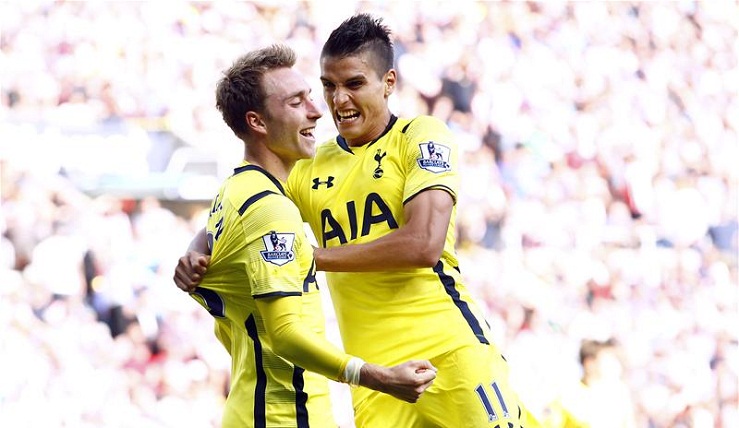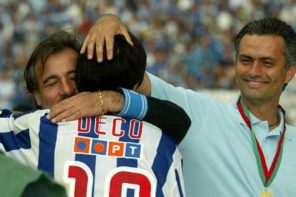They arrived in London as two of the most highly-rated youngsters in world football. But whilst one enjoyed a breakout campaign, the other endured nothing but breakdowns. Now, one season on and two managerial changes later, both Christian Eriksen and Erik Lamela are lighting up the Lane – together.
It’s fair to say Christian Eriksen’s arrival at Tottenham Hotspur went somewhat under the radar, despite being one of the most talked about talents in Europe (dating back to his early teen years in Denmark) and despite the ‘bargain’ £11m fee. The media attention was far too busy focusing on Spurs’ new record signing made on the same day: the £30m Erik Lamela.
By the end of the 2013/14 season, little had changed. The spotlight was still trained on Lamela – but this time more intensely and for all the wrong reasons – despite Eriksen winning Spurs’ Player of the Year award and becoming the team’s creative reference.
Lamela was under severe scrutiny as soon as he arrived at Tottenham; not just because of the hefty price tag, but also because many believed him to be a direct replacement for the team’s recently departed star, Gareth Bale, and seamlessly take up his mantle.
If comparisons to the Welsh winger – with whom he shares a few attributes with: left-footed, quick – were unjust, to state his first season in England as incredibly underwhelming wouldn’t be unfair. Although to label him a failure by not taking into account a series of mitigating circumstances would be.
The stark figures didn’t read well – showing a total of three Premier League starts, six substitute appearances amounting to just 361 minutes on the pitch, and one goal – scored against FC Sheriff in the Europa League group stages. It was in glaring contrast to the 33 appearances, 15 goals and five assists for AS Roma prior to his record transfer. What the figures don’t show is that the Argentine was beset by a series of injuries no sooner had he touched down in England, as well as suggestions of difficulty in acclimatising to a new culture – after all, Rome is more similar to his native Buenos Aires than London.
Then there was the AVB effect, whose presence was courting a growing negativity around the club. While the Portuguese manager can’t be adjudged as the sole cause of Lamela’s initial plight, it is true that Eriksen (who also suffered an indifferent start to life at Spurs, mustering just one assist and one goal in the Europa League) only flourished once he departed.
Under Tim Sherwood’s tenure the Dane playmaker produced 50 key passes (passes leading directly to a goalscoring opportunity) and conjured seven goals and eight assists from his final 18 games, no doubt leading to his end of season award. While Eriksen blossomed during this period Lamela continued to flounder; ultimately having his season cut short with a month to spare in a bid to overcome the series of niggling injuries and prepare for the future. As Sherwood himself confirmed:
We signed him for the long term and we are sure that, in the end, he will come good for Tottenham and be a crowd favourite here. It is just difficult to adjust to a different style of play and a different language. I’m sure Erik will pick it up. By the time he is fit, he will be fluent.
It was a future that Sherwood would play no further part in as Spurs chose to appoint Mauricio Pochettino – an Argentine who knew one of his first major issues was to get the best out of his talented countryman whilst somehow incorporating him into a system that already included a productive No.10 in Eriksen.
The solution?
Pochettino stated: “It depends on the situation whether Erik will play as the No10 or wide. My philosophy is to give a freer style with a good organisation and not only with Erik, with other players. The most important thing is to create a good shape for our players to be comfortable and to show their real qualities.”
So far a flexible 4-2-3-1 formation has allowed for both Lamela and Eriksen to interchange positions; at times starting wide, then drifting into the hole. After all, both are well versed in applying tactical flexibility to their attacking roles – despite operating best as bona fide No.10s – with the Dane being schooled in the Ajax philosophy and the Argentine learning a dual function whilst at River Plate.
“I discovered how to start from the wing when you have a panorama and have to make decisions,” Lamela said as a 19-year old, and there’s no doubting that is where he achieved his best run of form from whist at Roma – cutting in from the wing – although he has since stated he’s happiest when operating as a No.10.
During pre-season it was difficult to pin-point either player – particularly Lamela – such was the system’s fluidity, and at last, Spurs fans saw glimpses of the two operating in tandem, and perhaps more importantly, Lamela taking centre-stage – turning a 1-0 deficit into a 2-1 victory by providing two sublime assists after coming off the bench in the Europa League qualifier. His promising early season form has even led to a recall to the post-World Cup Argentina squad.
Soon after taking over Tottenham, Pochettino said of Lamela:
It is never easy in the first season for a player from another country. He was very disappointed about last season but the past is the past. We need him to look forward, believe in his skill and condition and work very hard. With confidence and time he will show his value.
It is important to know that Erik is still young and it is difficult to adapt to the Premier League – it is the most difficult league to play – the style, the language, but now, after one year at Tottenham, we believe that Erik is ready to show his quality.
In the team’s most recent Premier League fixture versus Southampton in October, Eriksen scored the winner whilst Lamela was awarded the game’s Man of the Match.
Finally, both playmakers are lighting up the Lane – together.







